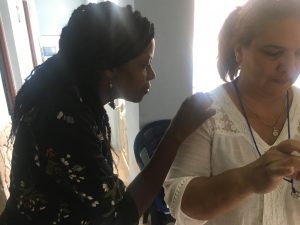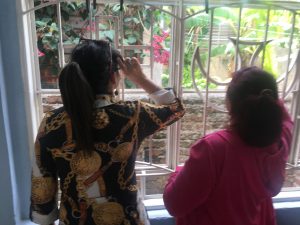
This is the third installment of a three-part series of reflections on Playing in the Pain.
By Mylinda Baits, PhD Candidate
Global Consultant for Training with the Restorative Arts
International Ministries
Both playing and pain are essential elements in my understanding of life, creativity, call and community. How can pain and play co-exist? Let me start with my own story. Twenty years ago, in preparation for our long-term move to Costa Rica, I was with my family at the Green Lake Conference Center for an orientation to work with International Ministries. We were each invited to do a spiritual journey timeline, indicating major life events that had shaped us up until that point. After listing our significant milestone experiences, we were to explore some common themes that came up. These themes could help us discern direction for future ministry and engagement in our cross-cultural call. As I completed my timeline, the theme that arose strongest for me was death. As a pastor, I had walked with several families through death and the grieving process. I had recently lost my 11 year old niece Tiffany to cancer and a friend to murder by domestic violence. Death and loss had come close to my life. I was, in my opinion, much too familiar with it. I was reluctant to follow this thread further into my future, hoping this new adventure would have more play than pain. I’d had enough of the latter. I pondered what it might mean for me and my beloved ones as we set out into the unknown of a new language, country, and culture. Questions raced through my mind: Was God preparing me to lose my kids, my husband or my own life in answering this call? Am I being called to suffer, to make the ultimate sacrifice for my faith? Am I up to this kind of challenge? The uncertainty of not knowing what lies ahead can surface some of our deepest, most existential fears, non-survival being a primary one.
As I debriefed the timeline with my orientation counselor, he listened with empathy, honored my experience and invited me to play in open curiosity with this emergent theme. By doing some thoughtful reflection, I was able to look from various angles and perspectives, finding new meaning and hope. Admitting my fears out loud with a compassionate witness allowed me to play around with more than one possible outcome. Exploring and expressing these fears with a trusted companion, allowed me to see new possibilities that I hadn’t before. In the process, not only was I more prepared for the unknown journey ahead, I was transformed by what we discovered along the way. He invited me to consider that I was being called into a ministry of compassion. Having walked through suffering, I was not afraid to enter it with others. The word compassion literally means “to suffer together.” Among emotion researchers, it is defined as the feeling that arises when you are confronted with another’s suffering and feel motivated to relieve that suffering. I have found this to be true for me. I cling to the following verse from 2 Corinthians 3-7: “Praise be to God and our Lord Jesus Christ, the Parent of compassion and the God of all comfort, who comforts us in all our troubles, so that we can comfort those in any trouble with the comfort we ourselves receive from God. For just as we share abundantly in the sufferings of Christ, so also our comfort abounds through Christ. If we are distressed, it is for your comfort and salvation; if we are comforted, it is for your comfort, which produces in you patient endurance of the same sufferings we suffer. And our hope for you is firm, because we know that just as you share in our sufferings, so also you share in our comfort.”
In early March of 2020, as the Covid-19 virus was just beginning to erupt on a global scale, I was in Holguín, Cuba facilitating an Expressive Arts in Transition group with my friend and colleague Shabrae Jackson Krieg. We were invited to work with a group of counselors and community leaders who were accompanying the families of those lost in the May 2018 plane crash. Of the 109 victims, close to 80 were from Holguín. I was invited in 2019 to co-create a memorial mosaic with the family and church members of 20 pastoral leaders who died in the accident. Experiencing the healing potential of the expressive arts in this occasion, my friends Ernesto and Marisol Bazán have mobilized and organized a group of community leaders, pastoral counselors and university professors to offer long-term psychosocial-spiritual accompaniment to the families and the entire community of Holguín. They invited me and Shabrae to help prepare this group for the significant task they were undertaking. Our focus was on Artful Accompaniment with Apapacho, using the Expressive Arts in Transition Model created by Melinda Ashley Meyer DeMott. The EXIT model has been rigorously field tested among unaccompanied asylum-seeking youth, as well as other trauma impacted populations. Dr. Meyer-DeMott is my PhD adviser and has been accompanying me in my Expressive Arts research as well. Artful accompaniment includes aesthetic exploration, expression and expansion of personal and collective resources for resiliency and growth after trauma. Apapacho is a beautiful Mayan word that means to caress or embrace with the soul. We discovered together how the seemingly incongruent elements of pain and play are inextricably linked in community building and healing.
Together we explored the metaphor of a road based on Antonio Machado’s image from his poem, “Caminante”: “Caminante, son tus huellas el camino, y nada más; caminante, no hay camino, se hace camino al andar. Al andar se hace camino, y al volver la vista atrás se ve la senda que nunca se ha de volver a pisar. Caminante, no hay camino, sino estelas en la mar.”
“Wanderer, your footsteps are the road, and nothing more; wanderer, there is no road, the road is made by walking. By walking one makes the road, and upon glancing behind one sees the path that never will be trod again. Wanderer, there is no road– Only wakes upon the sea.”
As walkers on the way, we each carry our own journeys making our roads as we walk along life’s way. We’ve each had different experiences, people and privileges that have impacted us. Whenever we enter a new shared space, like these weeklong workshops, our stories interact with the stories of others. Together we create a once in a lifetime encounter. Each contributes their own unique perspective and understanding. The diversity of experience, perspective and expression, adds texture, richness and complexity to the meeting, leaving ripples on each life like wakes upon the sea.
For the group gathered in Holguín, the plane crash of 2018 was their shared tsunami. Though manifesting in various ways, the physical, emotional, spiritual and relational impact of that day in history changed them forever. The common denominator in our exploration for the week was the powerfully painful experience of collective grief and loss. We wrestled with questions like: “How can we accompany others in the way of grief when we are walking through the mud of it ourselves?” “How can we offer support instead of solutions with so many unanswered questions?” ”How do we get more comfortable in the discomfort of not knowing?” ”How can I offer healing to others before being healed myself?” “Can we find the way to hope together?”
As we played with these questions, we were guided by five signposts or markers. These signposts along the way helped us to construct our shared road. The Expressive Arts in Transition model seeks to creatively nurture and strengthen these five resources for resiliency agreed upon by a large gathering of experts in the field of crisis and disaster intervention: safety, calm, connection, purpose and hope. “In times of uncertainty, art is more than beauty or decoration — it’s a tool. Art can heal, art can save lives, art can bring us together — even when we’re apart,” says Aaron Huey, founder of Amplifier. “It can be a compass to guide us through the storm.”
Ernesto shared that the reason he is passionate about accompanying the family members in their journey of grief after the accident was because he realized that not only surviving, but thriving is possible. Reflecting on his own journey of grief after the tragic loss of his father in an automobile accident when he was a teen he was more convinced than ever that this was a part of his calling. By playing in his own pain, he became a wounded healer.
A key component in the Expressive Arts approach is the expansion of the play range, the practice of presence and sensitive observation in the here and now. Recognizing the transformative power of the arts to hold paradox, to practice skills of adaptation and adjustment as situations change, to rejoice in the uncommon and mysterious, and to discover beauty in broken bits and pieces is to me, what play is all about. Play doesn’t deny reality, rather it engages it, in all of its’ whimsy, wounds and wonder. When explored and expressed in community, not only is reality transformed, but we are. We leave the encounter changed, different, enriched. As we accompany others and allow others to accompany us in artful apapacho, our souls feel safe, calm, connected, purposeful and hopeful, caressed and embraced with grace.
Today as I write this reflection, we are living through a global event that is impacting all of us. As we navigate the Covid-19 global pandemic, we are challenged to play IN the pain of uncertainty, separation, inequity and death. We share the same road, yet we walk it in very different shoes, some with no shoes at all. My compañer@s del camino (companions of the road) in Cuba are making adjustments to their new normal. No longer able to meet in person, like many of us, they are gathering on WhatsApp to practice arts-based coping skills that help them stay safe, calm, connected, purposeful and hopeful. They’ve invited me to join them on their call next week. We continue to make our shared road and because of them, I walk differently. I have played in the pain and I’m not the same. Thanks be to God!